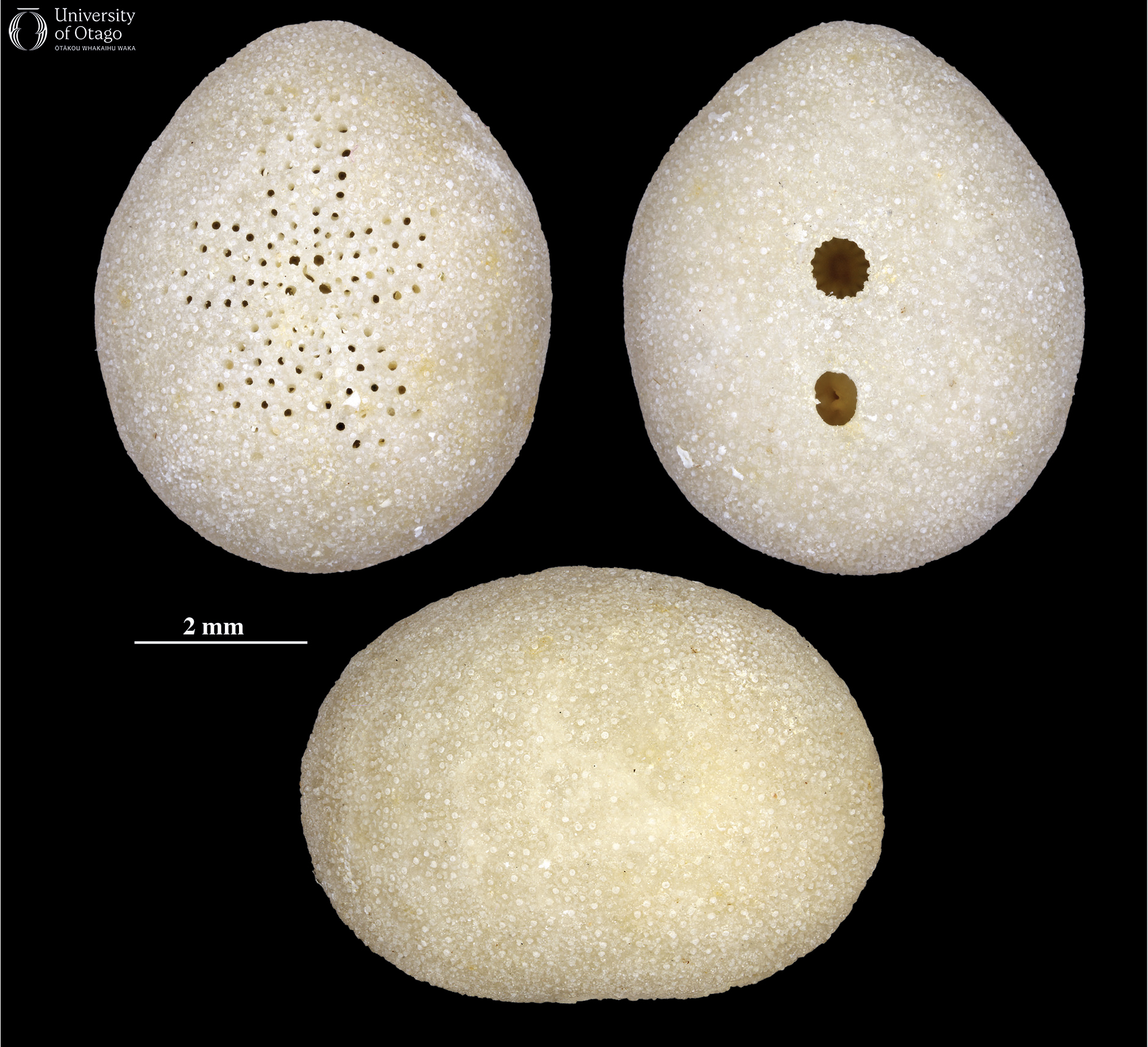31 Minute echinoids made a brief appearance in Aotearoa’s fossil record
Echinodermata, Echinoidea, Echinolampadaceae: Fibularia
One small and fragile genus of irregular echinoid that made a brief (in geological terms) appearance in Aotearoa New Zealand is Fibularia, a genus first named by the great French natural historian, Jean-Baptiste Lamarck, in 1816. These tiny, oval to almost globular, thin-walled echinoids are placed in order Echinolampadacea, along with the more familiar flattened sand dollars.

A tiny globular test of Fibularia sp. showing (left) the upper (aboral) surface with the star-shaped array of pores for the tube feet, (right) the lower surface (oral) with the mouth (peristome) and anal opening (periproct) and a side-on view. The surface of the test is covered with thousands of tiny tubercles which were the bases for a range of tiny spines. Image credit: JH Robinson. |
Although quite abundant in a few southern South Island sedimentary rocks of Duntroonian and Waitakian age, they then vanished from Aotearoa’s fossil record.
The earliest records in other parts of the world are from the Late Cretaceous, and there are around 27 named fossil species. The New Zealand examples have not yet been given a species name, however, being described only as Fibularia sp. When ‘sp.’ is used like this in a scientific name it means that the genus has been identified but the species has not. Six species are still present in modern oceans, ranging from the Red Sea where they inhabit seagrass beds, to the Indo-Pacific as far as Japan and Australia.
A paper published in 2015 looked in detail at 813 University of Otago Geology Museum specimens of Fibularia collected from Otekaike Limestone exposed in a quarry in South Canterbury. They are small enough, at less than 5 mm in length, for all specimens to fit inside a lunchbox.
The study was undertaken to examine the frequency of drillholes in these tiny echinoids. Such studies provide important data on ecological interactions between different species and document how predation may have changed through time. In this case, 57 individuals (7% of the total) were drilled: one unlucky little echinoid had four separate drillholes! The minute drillholes are circular in outline and appear to be concentrated on the upper (aboral) surface. In the case of predation, it can be challenging to determine the perpetrator – was this predation (the predator aimed to eat the echinoid) or possibly parasitism (the parasite lived on the Fibularia without killing its host)?
A more recent study by Yutong Wu identified two different types of drillholes in 111 specimens of Fibularia from Cosy Dell, a fossil locality 200 km further south, suggesting that Fibularia specimens were preyed upon by both predatory gastropods in the family Cassidae and parasitic gastropods in the family Eulimidae.
Fibularia animals live today partly buried in soft sandy sediment in shallow shelf environments. They are slow-moving detritivores, feeding on organic material and we can assume that the fossils had a similar lifestyle.
—Written by Daphne E Lee and Yutong Wu
| Specimen number: OU 43706 | Age: Approximately 24 million years ago (late Oligocene, Waitakian stage) |
| Locality: Hakataramea Quarry, Hakataramea Valley, South Canterbury | Rock Formation: Otekaike Limestone |
| Collected by: A Grebneff | |
| Citation: Meadows CA, Fordyce RE, Baumiller TK. 2015. Drill holes in the irregular echinoid, Fibularia, from the Oligocene of New Zealand. Palaios 30: 810-817. https://doi.org/10.2110/palo.2015.043 | |
The taxonomic rank that groups together closely related species. The genus forms the first part of the binomial species name.
27.3 to 25.2 million years ago.
25.2 to 21.7 million years ago.
A collection of fossils that document the history of life. Reference might be made to the history of life in a particular place ('the fossil record of New Zealand'), or the history of a particular group of organisms ('the fossil record of penguins'), or simply the global history of all life ('the fossil record').
100.5 to 66 million years ago. The final epoch of the Cretaceous Period.
Coarse-grained, sandy limestone.

